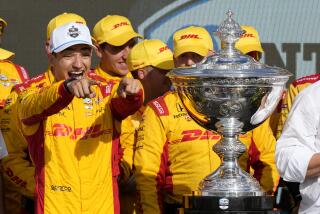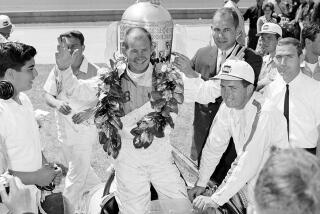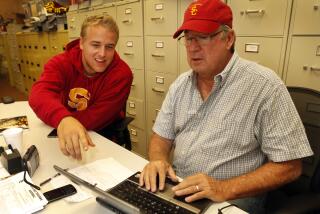Rick Mears Doesn’t Fail, the Car Does
You never have to look very far down the track for Rick Mears. If the car keeps running, try first. If he’s not there, you won’t have to wait long. In the five Indy 500 races in which his car was still on the track at the end of 200 laps, he finished 1st, 2nd, 3rd, 1st and 3rd.
If he were a pro golfer, he’d be shooting 70 every round. If he were a ballplayer, he’d be Wade Boggs, getting 200 hits every season. If he were a football player, he’d be Steve Largent, 10 receptions a game; if he were a fighter, Gene Tunney.
He’s the most consistent chauffeur on the circuit. He never brings the car home in a bag. He brings it home third or better.
If you want to measure the efficiency of a driver at Indy, you don’t necessarily check his lap time. You check his laps. The number of times his car was still on the track at the checkered flag. Rick Mears was still racing in 5 of his 10 rides at the Speedway. For Indy, that’s the rankest kind of dependability. He’s the most durable part of the car. The cliche applies to Mears: to finish first, first you have to finish.
But what you have to say about Rick Mears is, he’s not just a stroker, not just durable, dependable, he’s fast. Aside from those two Indy 500 wins, he lost the closest finish in Indianapolis’ history, 1/10th of a second behind Gordon Johncock at the finish line in 1982. Another year, 1981, he was leading the race when a failure in a fuel line during a pit stop set fire to the car. Also to him.
He holds the fastest qualifying record at Indy, 1 lap (217.581 m.p.h.) and 4 laps (216.828), and the record for the fastest lap ever run in the United States (234 m.p.h. at Michigan in 1986). He had the fastest qualifying lap ever run anywhere (223.401 m.p.h.) at Michigan in ’86.
He hits homers as well as singles, goes for the bomb as well as the first down. Not only can he putt, he can hit 1-irons. He can jab or punch.
What’s remarkable is that Rick Mears can do any of the above after what happened to him in Canada in 1984.
It was at Sanair, near Montreal. Now, guardrails are erected around a racing oval to defend drivers, keep them on the course. This one attacked. It had too much daylight under it when Rick Mears’ front end slammed into it. Not as much daylight as it would have when the force of the collision pulled the supporting posts out of the ground and turned the metal from a guardrail into a guillotine.
First, the railing wiped out the front end of the car. Then, it wiped out the back end of Rick’s feet. It started by pushing his feet back on themselves, snapping every bone in the right foot and half the bones in the left foot. The right foot was strapped to the accelerator and incapable of any evasive action.
Then, the metal sliced both Achilles’ tendons. Mears’ feet looked like two platters of steak tartare by the time they pulled the blade out of them. “The doctors,” Rick recalls, “said they were the worst-looking feet they had ever seen on somebody who was still alive.” He didn’t have feet, he had paws, bloody paws. They looked like they belonged to a bear in a trap, not a driver in a car.
The reconstructive surgery took 8 hours, 6 hours finding the pieces and 2 hours putting them back together. The surgeon was so sure he could not restore circulation to the feet, he went home, Mears says, and broke every piece of crockery in his kitchen in frustration.
He was wrong. Mears’ feet were just fine. He can tell when it’s going to rain, he can tell when an airplane reaches cruising altitude, his feet are as sensitive to changes in pressure as a ship’s barometer, but Rick Mears says, you don’t drive with your feet. It’s the other end of the motorist that’s critical, the mind. “What’s the sport you think concentration is most critical in? Golf?” he challenges. “Well, we had a bunch of professional golfers at an IROC race and we put them in the cars, and every one of them came out bug-eyed and said, ‘Cripe, we thought we had to concentrate! But we can take a rest from green to tee. Here, you let your mind wander for one instant and it’s over.”
At 234--or 216--m.p.h., you can’t take time to smell the flowers--or they’ll be lilies.
Mears has the concentration of a diamond-cutter. It was what impressed Roger Penske into offering him a ride with his team when he first encountered young Rick at a Colorado motorcycle rally in the late 1970s.
Now, Penske’s Pennzoil racing team is to motor sport what the Ruth Yankees were to baseball, or Rockne’s Notre Dames to football. Mears fit right in with the tradition. He became the first rookie to break the 200-m.p.h. qualifying speed at Indy. In his second year, he not only won the pole, he won the race, only the 10th driver in history to go from pole to Victory Lane.
He was back driving almost before he could walk in 1985. Within two years, he was third again. He will be the one to beat at Indy this May. One thing the winner can be sure of: He’ll have Rick Mears in his rear-view mirror. If Rick Mears ain’t in his rear-view mirror, he ain’t the winner. He’s in Rick’s rear-view mirror.
More to Read
Go beyond the scoreboard
Get the latest on L.A.'s teams in the daily Sports Report newsletter.
You may occasionally receive promotional content from the Los Angeles Times.










